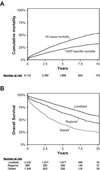Epidemiology of gastrointestinal stromal tumors in the era of histology codes: results of a population-based study
- PMID: 25277795
- PMCID: PMC4294949
- DOI: 10.1158/1055-9965.EPI-14-1002
Epidemiology of gastrointestinal stromal tumors in the era of histology codes: results of a population-based study
Abstract
To date, all population-based epidemiologic data on gastrointestinal stromal tumor (GIST) in the United States predate the 2001 implementation of GIST-specific histology coding. As such, results from previous studies were limited because of inclusion of non-GIST abdominal or gastrointestinal sarcomas. We used a national cancer registry with modern day histologic codes to gain greater insight into the true epidemiology of GIST in the United States. We identified 6,142 patients diagnosed with GIST between 2001 and 2011 in the Surveillance, Epidemiology, and End Results database. Incidence, survival, demographic risk factors, and prognostic factors were analyzed. Annual age-adjusted incidence rose from 0.55/100,000 in 2001 to 0.78/100,000 in 2011 and increased with age, peaking among 70- to 79-year-olds (3.06/100,000). GIST was also more common in males than females [rate ratio (RR), 1.35], non-Hispanics than Hispanics (RR, 1.23), and blacks (RR, 2.07) or Asians/Pacific Islanders (RR, 1.50) than whites. The study period had 5-year overall and GIST-specific survival rates of 65% and 79%, respectively. The 5-year overall survival rates for those with localized, regional, and metastatic disease at diagnosis were 77%, 64%, and 41%, respectively. Multivariate analyses demonstrated that older age at diagnosis, male sex, black race, and advanced stage at diagnosis were independent risk factors for worse overall survival. Multivariate analysis also showed the four aforementioned characteristics, along with earlier year of diagnosis, to be independent risk factors for worse GIST-specific survival. As the first population-based, epidemiologic study of histologically confirmed disease, our findings provide a robust representation of GIST in the era of immunohistochemical diagnoses.
©2014 American Association for Cancer Research.
Conflict of interest statement
Figures

Comment in
-
Epidemiology of GIST in the Era of Histology Codes--Letter.Cancer Epidemiol Biomarkers Prev. 2015 Jun;24(6):998. doi: 10.1158/1055-9965.EPI-15-0001. Cancer Epidemiol Biomarkers Prev. 2015. PMID: 26033756 No abstract available.
References
-
- Perez EA, Livingstone AS, Franceschi D, Rocha-Lima C, Lee DJ, Hodgson N, et al. Current incidence and outcomes of gastrointestinal mesenchymal tumors including gastrointestinal stromal tumors. Journal of the American College of Surgeons. 2006;202:623–629. - PubMed
-
- Miettinen M, Lasota J. Gastrointestinal stromal tumors--definition, clinical, histological, immunohistochemical, and molecular genetic features and differential diagnosis. Virchows Archiv : an international journal of pathology. 2001;438:1–12. - PubMed
-
- Fletcher CD, Berman JJ, Corless C, Gorstein F, Lasota J, Longley BJ, et al. Diagnosis of gastrointestinal stromal tumors: A consensus approach. Human pathology. 2002;33:459–465. - PubMed
-
- Tran T, Davila JA, El-Serag HB. The epidemiology of malignant gastrointestinal stromal tumors: an analysis of 1,458 cases from 1992 to 2000. The American journal of gastroenterology. 2005;100:162–168. - PubMed
-
- Blanke C, Eisenberg BL, Heinrich M. Epidemiology of GIST. The American journal of gastroenterology. 2005;100:2366. - PubMed
Publication types
MeSH terms
Grants and funding
LinkOut - more resources
Full Text Sources
Other Literature Sources
Research Materials

